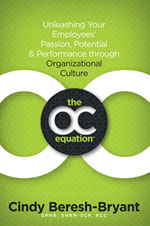Organizational Culture (OC) permeates EVERYTHING! Like it or not, it’s who you are as an organization, not who you want to be – so be something GREAT!
Culture is Always Parroted Back
Over the past two weeks I’ve been helping one of my client’s recruit for an opening and it’s been a real eye opener into their real OC. Remember the old adage, “the apple doesn’t fall far from the tree”? Well, it doesn’t in culture either because your OC is all about your organization’s shared values, beliefs and practices (the tree) and your actions don’t fall far from your culture.
Let me explain. Recently one of my clients needed to recruit for an open position. In HR we initiated the recruiting process and began screening candidates. When we began referring what we considered highly qualified, talented candidates to the hiring manager, we began hearing some disturbing comments from the leader – comments like, “she’s too old”, “what’s she look like?”, “he’s friends with ___________”, etc.
You get the picture – nothing at all to do with the job. A couple of days went by after we heard those comments and low and behold I started hearing them parroted by direct reports of this leader. You see, age, looks and who they know were the shared values, beliefs and practices for hiring in this organization; not because those have anything to do with hiring great talent or support any stated values or philosophies, but because those are the actions that get your hired, rewarded or fired.
And the “friends” comment, that comes from a shared belief that no one’s friends should be hired. While on the surface that may seem noble and consistent with a strong nepotism policy and desire to demonstrate integrity, their reason has nothing to do with that. As a matter of fact, while no one’s friends can be referred for consideration for employment, top leaders’ refer and “recommend” friends and family members all the time; driving a culture of cynicism, fear, and paradox.
Now, contrast that image of OC with another client who works tirelessly to reinforce an intentional OC carefully designed to help people deliver their best work. This client painstakingly defined their values and philosophies and considers every decision they make through the lens of those values ensuring that their actions are consistent with their intentional OC. In this organization, they hire the best talent they can afford from a slate of highly qualified candidates, many of whom are referred by employees. The difference is there is no one in this organization that would even dream of referring someone they didn’t believe would “fit” and support the OC. The apple truly doesn’t fall far from the tree and in this organization people parrot the values, philosophies and actions of the leaders too, but to the benefit rather detriment of the organization.
Where Employee and Organizational Needs Meet
The 6 basic needs of employees never change. The need for stability, challenge, recognition, belonging, development and purpose (to make a difference). What does, and has changed over time, is how those needs are interpreted by employees through how they live and work. Today, employees care as much about purpose as they do about a paycheck and they not only need a good boss, they need great colleagues. HubSpot’s culture code recognizes these changes and has intentionally built an OC to support them, understanding that a great OC will in turn support the organization.
People Development – The intentional reinforcement of OC
Great OCs don’t just happen. They are always intentionally developed and reinforced to meet employee needs with the belief that when employee needs are addressed through OC, employees deliver their best work, which in turn is leveraged as a true competitive advantage.
According to Fortune’s 2014 Best Places to Work, “When it comes to employee development, the 100 Best are inclined to spend more time and money investing in employees. On average, the 100 Best provide 73 hours of on-the-job training for full-time employees, compared to 38 hours among non-winning list applicants. From creating individualized development plans for each employee to placing a greater emphasis on succession planning, the 100 Best are committed to developing and advancing their people, understanding that retention is a competitive advantage whose value will only increase as the competition for talent heats up.”
In his book, Disney U – How Disney University Develops the World’s Most Engaged, Loyal and Customer-Centric Employees, Doug Lipp characterizes this way:
“…Disney University isn’t a car wash through which employees can be sent in preparation for work. It is much, much more. Training cannot be limited to ‘here’s what you need to do, now go do it.’ That’s not good enough. Training needs to instill a spirit, a feeling, an emotional connection. Training means creating an environment of thinking and feeling.”
Strong OCs never just happen. They are driven by The OC Equation™ (values + philosophies x actions = OC) and the intentional defining of your shared values and philosophies and then living those values and philosophies through intentional actions designed to reinforce them, such as incorporating The OC Equation ™ into every employee learning and development program.
The apple never falls far from the tree, the question is, is the tree tainted?
“..Our final advantage is the hard-to-duplicate culture that permeates Berkshire… in businesses, culture counts.” ~ Warren Buffet




